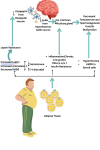Obesity: A Doorway to a Molecular Path Leading to Infertility
- PMID: 36320802
- PMCID: PMC9612950
- DOI: 10.7759/cureus.30770
Obesity: A Doorway to a Molecular Path Leading to Infertility
Abstract
The dramatic rise in obesity has recently made it a global health issue. About 1.9 billion were overweight, and 650 million global populations were obese in 2016. Obese women suffer longer conception time, lowered fertility rates, and greater rates of miscarriage. Obesity alters hormones such as adiponectin and leptin, affecting all levels within the hypothalamic-pituitary-gonadal axis. Advanced glycation end products (AGEs) and monocyte chemotactic protein-1 (MCP-1) are inflammatory cytokines that may play an important role in the pathophysiology of ovarian dysfunction in obesity. In obese males, there are altered sperm parameters, reduced testosterone, increased estradiol, hypogonadism, and epigenetic modifications transmitted to offspring. The focus of this article is on the possible adverse effects on reproductive health resulting from obesity and sheds light on different molecular pathways linking obesity with infertility in both female and male subjects. Electronic databases such as Google Scholar, Embase, Science Direct, PubMed, and Google Search Engine were utilized to find obesity and infertility-related papers. The search strategy is detailed in the method section. Even though multiple research work has shown that obesity impacts fertility in both male and female negatively, it is significant to perform extensive research on the molecular mechanisms that link obesity to infertility. This is to find therapeutics that may be developed aiming at these mechanisms to manage and prevent the negative effects of obesity on the reproductive system.
Keywords: adipokine; cytokines; hypothalamic-pituitary-gonadal axis; infertility; inflammation; insulin resistance; obesity; ovarian dysfunction; sperm parameter.
Copyright © 2022, Ahmad et al.
Conflict of interest statement
The authors have declared that no competing interests exist.
Figures





Similar articles
-
The Molecular Basis of Male Infertility in Obesity: A Literature Review.Int J Mol Sci. 2023 Dec 22;25(1):179. doi: 10.3390/ijms25010179. Int J Mol Sci. 2023. PMID: 38203349 Free PMC article. Review.
-
Role of hormonal and inflammatory alterations in obesity-related reproductive dysfunction at the level of the hypothalamic-pituitary-ovarian axis.Reprod Biol Endocrinol. 2018 May 9;16(1):45. doi: 10.1186/s12958-018-0366-6. Reprod Biol Endocrinol. 2018. PMID: 29743077 Free PMC article. Review.
-
Potential Adverse Effects of Female and Male Obesity on Fertility: A Narrative Review.Int J Endocrinol Metab. 2020 Sep 28;18(3):e101776. doi: 10.5812/ijem.101776. eCollection 2020 Jul. Int J Endocrinol Metab. 2020. PMID: 33257906 Free PMC article. Review.
-
[Research progress in obesity-induced low fertility in males].Zhonghua Nan Ke Xue. 2018 Dec;24(12):1132-1137. Zhonghua Nan Ke Xue. 2018. PMID: 32212496 Review. Chinese.
-
The Mechanisms Involved in Obesity-Induced Male Infertility.Curr Diabetes Rev. 2021;17(3):259-267. doi: 10.2174/1573399816666200819114032. Curr Diabetes Rev. 2021. PMID: 32814535 Review.
Cited by
-
Mapping the Landscape of Obesity Effects on Male Reproductive Function: A Bibliometric Study.Endocr Metab Immune Disord Drug Targets. 2024;24(13):1546-1557. doi: 10.2174/0118715303271117231220072051. Endocr Metab Immune Disord Drug Targets. 2024. PMID: 38299282 Free PMC article.
-
Exploring the impact of lipid stress on sperm cytoskeleton: insights and prospects.Nat Rev Urol. 2025 May;22(5):294-312. doi: 10.1038/s41585-024-00952-1. Epub 2024 Nov 11. Nat Rev Urol. 2025. PMID: 39528754 Review.
-
Mechanisms of Prostate Cancer Cells Survival and Their Therapeutic Targeting.Int J Mol Sci. 2023 Feb 2;24(3):2939. doi: 10.3390/ijms24032939. Int J Mol Sci. 2023. PMID: 36769263 Free PMC article. Review.
-
Effects of acetate-producing Blautia wexlerae on oxidative stress and NLRP3 inflammasome in obesity-associated male infertility.Med Microbiol Immunol. 2024 Jun 28;213(1):11. doi: 10.1007/s00430-024-00796-x. Med Microbiol Immunol. 2024. PMID: 38940844
-
The Relationship Between Body Composition Parameters and the Intake of Selected Nutrients, and Serum Anti-Müllerian Hormone (AMH) Levels in the Context of Ovulatory Infertility.Nutrients. 2024 Nov 29;16(23):4149. doi: 10.3390/nu16234149. Nutrients. 2024. PMID: 39683543 Free PMC article.
References
-
- Obesity and Overweight. [ May; 2022 ]. 2022. https://www.who.int/news-room/fact-sheets/detail/obesity-and-overweight https://www.who.int/news-room/fact-sheets/detail/obesity-and-overweight
-
- European Society of Endocrinology Clinical Practice Guideline: endocrine work-up in obesity. Pasqual R, Casanueva F, Haluzik M, et al. Eur J Endocrinol. 2020;182:1–32. - PubMed
-
- Panuganti KK, Nguyen M, Kshirsagar RK. Treasure Island: StatPearls; 2022. Obesity. - PubMed
Publication types
LinkOut - more resources
Full Text Sources
Research Materials
Miscellaneous
